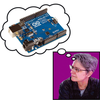Using the Raspberry Pi as a Minecraft server
Minecraft [1] is a game about constructing things out of simple blocks. This straightforward theme has attracted millions of fans since its introduction in 2009. The game offers players various play modes for exploring virtual worlds, building habitats, or even taking on an elaborate project like the construction of a virtual computer [2].
It is even more fun for many players to explore the Minecraft world together. The prerequisite for multiplayer games is the Minecraft server. The server does not necessarily require a high-performance computer, however, so a Raspberry Pi will suffice. Once a server is set up properly, nothing stands in the way of multiple rounds of play.
The Right Server
Surprisingly enough, there is no preferred Minecraft server. Instead, several options can be found online, including, for example, the official Minecraft Multiplayer Server [3], which works without much need for modifications, resulting in the nickname "vanilla server."
[...]
Buy this article as PDF
Pages: 6
(incl. VAT)







